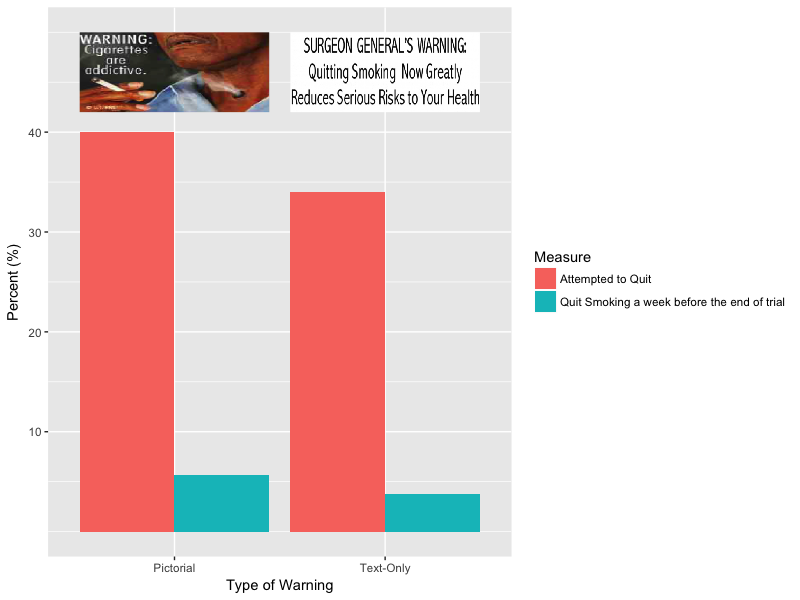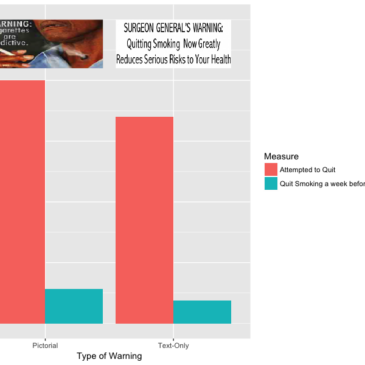The individual, familial and societal costs of smoking are staggering. Adding pictures that warn about the dangers of smoking to cigarette packs is one policy approach to nudge smokers towards quitting. Most studies – across several countries — that have studied the effect of these pictorial warnings have found that they increase quit attempts and reduce the prevalence of smoking. However, a few studies have shown that the effect does not always hold. The ASHES, this week, reviews a study by Dr. Noel T. Brewer and colleagues, that used a randomized clinical trial design to test the effect of these warnings.
What was the research question?
How does adding pictorial warnings to the front and back of cigarette packs affect smoking behavior?
What did the researchers do?
The researchers recruited 2,149 adult smokers in North Carolina and California for the study. About half of the participants were assigned to receive text-only warnings, while the other half were assigned to receive pictorial warnings[1]. During each visit, the research staff took the cigarette packs that the participants brought[2], and applied self-adhesive pictorial or text-only warnings to the front and back of their cigarette packs. Each week, participants reported about their attempts to quit smoking. During their final visit, participants also completed a survey about their reactions to the warning messages and their smoking attitudes and expectations.
What did they find?
The primary finding of the study was that pictorial cigarette pack warnings discourage smoking. Forty percent of participant who saw pictorial warnings tried to quit, compared to 34% in the text only condition. Further, the study also found that 5.7% of those receiving pictorial warnings had quit smoking one week prior to the end of the trial, compared to 3.8% of those exposed to text-only warning (see Figure 1). Participants who received the pictorial warning messages had stronger emotional and cognitive reactions such as fear and thinking about the harms of smoking, and more conversations about the warning than those who received text-based warnings.

Figure. The percent of participants who attempted to quit and actually quit smoking a week before the end of the trial in the pictorial and text-only warning groups. Adapted from Brewer et.al., 2016). Click image to enlarge.
Why do these findings matter?
The 2009 Family Smoking Prevention and Tobacco Control Act made pictorial warnings on cigarette packs mandatory. However, a lawsuit by the tobacco industry in the US Court of Appeals for the District of Columbia Circuit has since stalled the implementation of the Act. In ruling against the pictorial warnings, the Court stated: “FDA has not provided a shred of evidence…showing that the graphic warnings will ‘directly advance’ its interest in reducing the number of Americans who smoke.” The results of this clinical trial begin to provide that evidence.
Every study has limitations. What are the limitations in this study?
As the study was conducted over a period of one-month, it is not clear how the behavior of participants would have unfolded over a longer amount of time. Further, as participants were told that the goal of the study was to examine how smokers understand the labels on their cigarette packs, it is feasible that some of the participant’s responses were influenced by what they perceived to be the researchers’ expectations.
For more information:
Individuals who are concerned about their own smoking or vaping can find resources to help them quit at smokefree.org. Others struggling with their substance use more generally may benefit from using SAMHSA’s National Helpline. For additional tools, please visit the BASIS Addiction Resources page.
— Pradeep Singh
What do you think? Please use the comment link below to provide feedback on this article.
________________
[1] The researchers used a total of eight warnings: four text-only warnings using the US Surgeon General’s warning statements, and four pictorial warnings selected from an FDA’s set.
[2] Participants were told to bring 8-day supply of cigarettes to their first visit, as well as to 4 follow-up visits spaced one-week apart.




